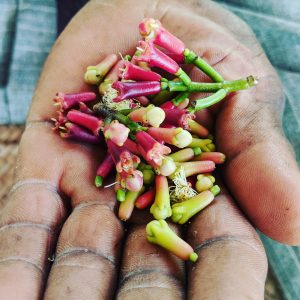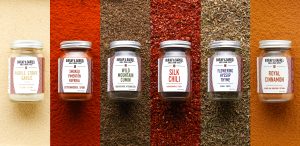This week Food Karma’s Communications Director, Dylan Heuer talked with Sauce King NYC judge Ori Zohar. Ori is the co-founder of Burlap & Barrel, a single origin spice company. He comes from a business, marketing and operations background but Burlap & Barrel wasn’t his first foray into food. In 2010, Ori started an activist ice-cream cart in New York City, serving flavors inspired by political movements around the world and donating the profits to charity. Seven years later Ori and his partner in the endeavor, Ethan Frish, wanted to take their activist business model to the next level and founded Burlap & Barrel together. The spice company is a certified Public Benefit Corporation, working to build new international food supply chains that are equitable, transparent and traceable. Dylan asked Ori about what this mission looks like in practice, how home cooks can better utilize their spice cabinet, and what he’ll be tasting for as a Sauce King NYC judge.
The following interview has been edited lightly for clarity and length.

Dylan Heuer: Explain what it means to be a provider of “single origin” spices.
Ori Zohar: Throughout our history the sourcing and origin of spices has been obscured. Most spices you get in your grocery store have gone through a really long journey. They’ve changed hands 15-20 times. They’ve taken more than three years to just get into that grocery store. And every time they change hands, prices go up and quality goes down. Good and bad quality spices get mixed together and there’s a lot of opportunity for adulteration, which we see very frequently in spices.
What we’re trying to do with spices is exactly what’s happened with coffee and tea and chocolate and produce and meat; where you know where all that stuff comes from. Part of the quality of it is that it came straight from a farmer and you know how it got to you. We’re just doing the same thing with spices. We’re telling people that spices come from plants and seeds and nuts and fruits. We tell people that cinnamon is tree bark and peppercorns grow on vines in bunches like grapes do. And also, here’s the farmer that grew them. And here’s when it was grown. And here’s how they became a farmer in spices. We’re trying to share these stories that are interesting, but also speak to the quality of the spice. We know where it came from; we know when it was harvested; we know the entire path that it took from the farmers’ fields all the way into your kitchen.
DH: There are a lot of things that make Burlap & Barrel unique in the spice industry. How are you working with small-holder farms and developing alternative supply chains?
OZ: Even the best spice companies in the U.S. are just trying to pick the best spices from different importers that have come through a pretty long process to get into the U.S. What we do instead is go directly to the farmers. We talk to them and then jump on a plane and go to the central mountains of Vietnam to meet the group of cinnamon farmers letting the trees grow for 20 years before they harvest them. Or we’ll go to Zanzibar, where there’s a cooperative farm reserve growing organically, regeneratively; growing incredible nutmeg and cloves that Zanzibar is world famous for.
This level of work with the farmers [involves] figuring out what they think is the best thing that they grow. Very often, the spice industry will rank things based on color or size or shape, which are really not related to flavor. In Guatemala our partner farmer likes to let his green cardamom ripen on the vine until it turns yellow and it gets this riper, fruitier, floral flavor that you really love. But in that part of the world, yellow cardamom is rated lower than green cardamom and we have no idea why. So we like to work with the farmers, see what they think is the most special thing they grow and what they’re most excited about, [then] find a way to bring it into the U.S. and to introduce it to home cooks across the country.

DH: What’s a spice that more home cooks should have in their spice cabinet?
OZ: I have been using our ground black lime on everything. Ground black lime is just made from dried limes. People call them Persian limes, but really we know them in the U.S. as just limes; they’re the common lime in most grocery stores. These black limes are dried and they’re typically used whole in Persian cooking, where they’re put in soups and stews and dishes like that. We took the whole limes and ground them into powder. You get this citrusy, bright, kind of savory black powder that you can sprinkle over anything from toppings on hummus, baba ganoush, guacamole, to even using it on the rim of a margarita glass, or in salad dressings. We use it anywhere where you use a squeeze of lemon or lime and it really just amps up the flavor and brings light citrusy-ness to anything you put it on.
DH: How much consumer education is required in the work you’re doing?
OZ: Everybody has spices in their home that they’ve been using one way or another, but many people just do it based on a recipe; like they’ll bust out their coriander for one specific recipe. We’re trying to tell people that [they] should just sprinkle spices on top of dishes they already know how to cook. You know, if you make a mean spaghetti, grind some coriander [on that], try some urfa chile, or maybe some sumac and see how it changes the flavor. I think people sometimes approach their spice cabinet with a little bit of intimidation. And we’re just really big supporters of keeping spices by your stove the same way that you keep salt and pepper. Pick three spices and put them right next to the salt and pepper and try to integrate them into the different dishes that you cook in the coming week. Then the next week, pick three different spices. We think that’s the best way to do it. Start by smelling it, start by tasting it, and then sprinkle it onto whatever you’re cooking with. It doesn’t have to be a very specific thing. Spices are an amazing way to add flavor, that usually doesn’t involve salt, sugar or fat – it’s a much broader palette to paint with.

DH: To switch gears into the world of sauces and Sauce King NYC, are you working with any saucemakers now through Burlap & Barrel?
OZ: Sir Kensignton’s puts our tumeric in a number of their salad dressings, which has been really fun to see. There’s 88 Acres, which makes sauces and snacks out of watermelon seeds and other seeds. [and] uses our ground black lime in one of their salad dressings. We’re still waiting for somebody to pick up our spices for a proper barbecue sauce. I’m a huge fan of paprika in sauces. I’m a huge fan of the smoked chilies and adding some of that umami depth into it. We’ve had a few folks reach out to us and make sauces with a number of our spices [but] I think that spices are underrepresented in the sauce category. So I’m really curious to see what the makers come up with [for Sauce King NYC].
DH: As a judge for Sauce King NYC, what will you be looking for?
OZ: I’m really interested in both incredible takes on the classics, but also the creative versions of sauces and seeing how people are looking at the category of sauces and making a new thing. I’m going to be looking for bright and strong interesting flavors. I think the role of a sauce is to take something and really make it stand out; to both complement the original flavor of whatever it’s put on and also bring out something new in there that maybe you wouldn’t have noticed [otherwise].
I want to see creativity in the sauces. I want to see ingredients that I wouldn’t expect. I’m dying to see all kinds of spices and mushroom powders and other interesting ingredients used in creative ways. And so that’s what I’m really looking forward to. I know how much spices can change what we eat and give you so many more interesting flavors to be able to incorporate. So I’m really curious to see how people are going to be incorporating spices. Obviously chilies, but I’m also curious to see how people are going to be reaching out to other spices and putting them in their sauce and creating interesting flavors through that.
